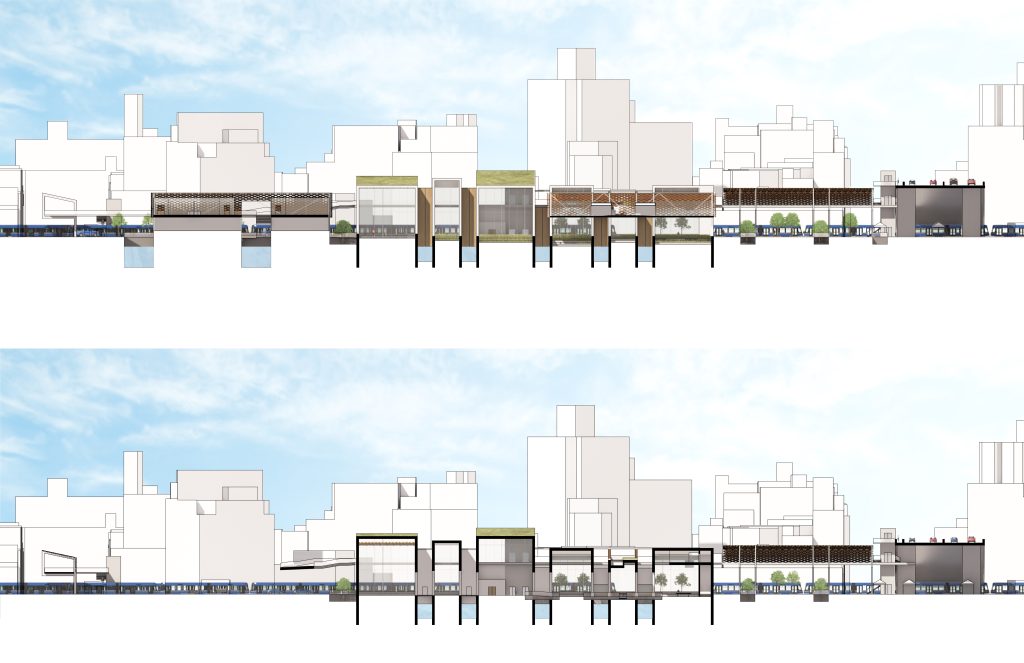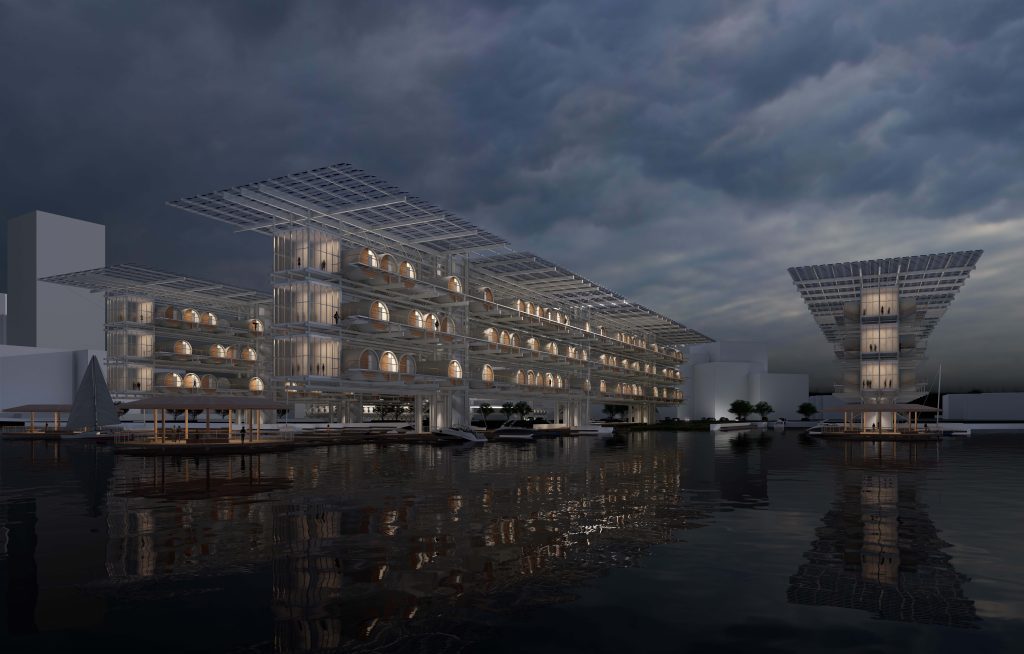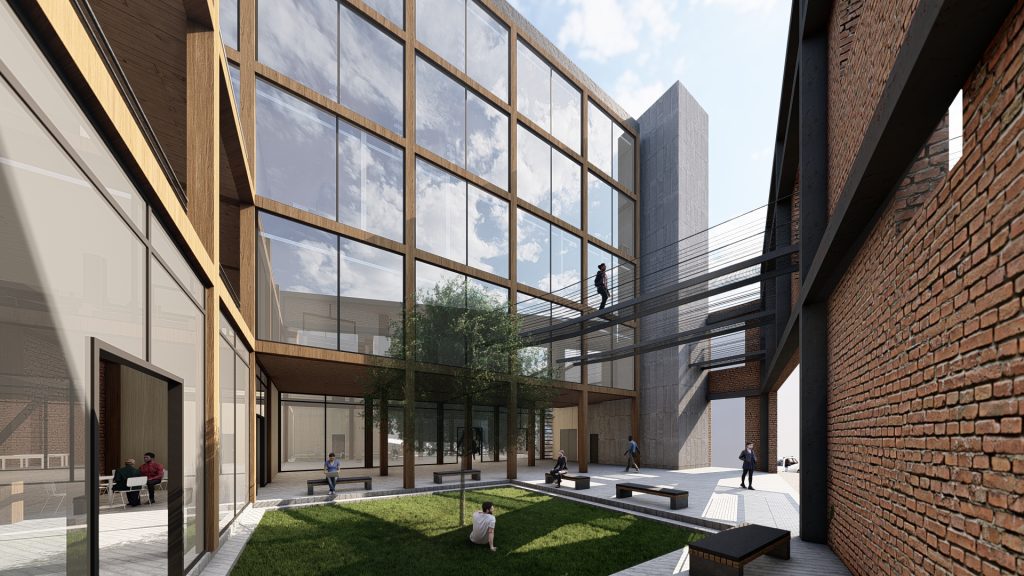
Thursday, May 16, 2024
By: Kyle Niblett
When he walked across the stage last week at the University of Florida College of Design, Construction and Planning Student Recognition Ceremony, Kyle Wilson O’Quinn’s eyes glazed upward, deliberately over Dean Chimay Anumba’s shoulder.
To the Fort White, Florida, native, Joanne Dials was the most important person in the 10,000-seat arena that day. Acknowledging her was even more important than shaking the Dean’s hand.
You see, Dials isn’t just any random person. She is O’Quinn’s grandmother and the person he gives all the credit to for him becoming the first graduate to have written a thesis at the UF School of Architecture JaxLab.
“After my mother’s death as a child, I changed schools often as result of my father’s repeat incarceration, making it hard to maintain a consistency in my academic progress,” O’Quinn explained. “If it were not for my grandmother taking care of my sister and I when our parents were not able to, I would not be here today.”
Before her, little to no value was placed on education, leading O’Quinn to be disruptive and often isolated at a separate desk in the corner of the class. However, even at a young age, he found himself drawing cities, sometimes using thick paper to cut them out with fold down tabs. By effectively creating his own world within this pop-up city, he was becoming an architect despite not knowing what that meant.
With classes described as “intellectually boring, slow paced, and overly regimented”, his low participation rate and poor effort continued. It was finally at Columbia High School in Lake City where he took eight total building and construction classes and came to the realization that he enjoyed building things. O’Quinn credits a moment in 10th grade where he was challenged by his English teacher Mrs. Ray to write a paper on his vision after high school.
“This paper was pivotal for me and represented the moment when I committed to becoming an architect,” he said “Yet, I barely graduated high school. If I remember correctly, I had something like a 2.4 GPA.”
With a low GPA and little aspirations about going to college, O’Quinn bounced around a couple junior colleges before getting his Associate of Arts degree. With the AA degree in hand, he researched the best places to get an architecture degree in the state of Florida. When UF kept coming up as the best, he shot his shot and applied to be a Gator in the fall of 2017. Like everything else growing up, it didn’t come easy – his first application was denied.
“I wanted to attend UF not only because of its top academic status, but also as a point of pride,” O’Quinn said. “In my high school, it was common for the top students to attend UF after graduating, which always seemed well out of my reach. This was one shot.”

By the time he was accepted after a second time applying, the hunger was stronger than walking into a good-smelling kitchen with his grandmother’s cooking. Motivated like never before, O’Quinn dove into the compressed summer semester and spent late nights and early mornings compressing his time into adrenaline-fueled productivity. After receiving his bachelor’s degree in architecture, he realized his unconventional journey to success wasn’t done yet. O’Quinn arrived in Jacksonville knowing he had the ability to help shape an entire program.
“The ability to help build out the CityLab Jax program gave me a lot of control over my studies, allowing me to focus in on the things that were important to me and really drive the directionality of my graduate education,” O’Quinn said. “That opportunity has been invaluable, and I cannot thank the faculty at UF enough for allowing it.”
Having worked full-time or part-time since 2018, O’Quinn grinded on his own with no financial handouts in order to pay for his education. Following his bachelor’s degree in 2022, he interned for Pelli Clarke & Partners in New York City. He has been with them since, happy to attach his name and work to the same firm renowned for designing some of the world’s most iconic buildings and structures, including: the Petronas Towers in Kuala Lumpur, Malaysia, the World Financial Center (now Brookfield Place) in New York City, and The Salesforce Tower (formerly Transbay Tower) in San Francisco.
“Although I moved back to Florida to finish my master’s degree, the partners allowed me to work remotely from the Sunshine State with the potential of returning after graduation,” the Pelli Clarke & Partners preceptee said. “I feel lucky to be a part of the team and the experience I’ve gained already has been invaluable.”
As an intern there, he performed similar tasks to that of an entry level designer: researching product specifications, making corrections based on drawing markups, modeling site context, preforming design studies, creating presentations, attending coordination meetings internally and with consultants, and preparing document sets.
“I have also been given the opportunity to participate in multiple phases of a variety of project types, as well as multiple design competitions for some very exciting prospects around the globe,” O’Quinn explained.
By rising from a small town to a big city, the two-time Gator graduate is very grateful to have made history. Being the first graduate of JaxLab to have written a thesis is a point of pride for him because it represents his commitment to taking advantage of new opportunities as they arise. It cements a trailblazing legacy that will reflect in his work moving forward as well.
“For me, the thesis represents a longstanding academic tradition that holds weight across academic disciplines, making it a useful tool for connecting between them,” said O’Quinn, whose thesis was written about the influences of Cartesian philosophy on the American countryside. “By seeking to understand how prevailing philosophical underpinnings shape the rural-urban relationship, it demonstrates the realities and manifestations of how conceptual frameworks paired with new scales of human impact are rapidly changing the character of the American landscape.”
Through this thesis, his time in the Big Apple and his degree from JaxLab, O’Quinn has seen first-hand the importance of the Gator Nation across the globe.
“I cannot understate how important the UF network of graduates has been for me,” he said. “I have met many UF faculty and alumni who reinforced my sureness about attending UF in their ability to act as role models. During my undergraduate studies, relationships with alumni often offered office touring or guest speaking opportunities for our studios and supporting coursework. Even my current employment is the result UF SoA Advisory Council member Craig Copeland, a DCP graduate who is very interested in extending the Gator legacy.”
Speaking of legacy, O’Quinn knows he is well on his way to leaving his own. To undergraduate architecture students across the nation, he recommends the Jacksonville studio because it provides a great deal of flexibility and academic freedom. Applauding its “tight-knit and incredible supportive” atmosphere, he is quick to point out the low number of students also means students get more one-on-one time with professors who tend to become much more involved in ensuring your success during and beyond the program.
“The feeling of being an integral part of something with a supportive community is quite fulfilling,” O’Quinn finished with. “Finally, I think there is a ton of opportunity in Jacksonville because the city is the perfect size for the potential of having a real impact on its development if one was to choose to pursue a career here. The city has a strong foundation in arts and culture and stands at the precipice of redefining itself as it moves into a new era.”
After all, Jacksonville is close to home, and close to grandma.

Q&A with Kyle Wilson O’Quinn
Q: What was your favorite courses or work done as a JaxLab student?
A: My final studio and thesis have been my favorite part of my education at JaxLab by far. My last studio, led by Professor Michael Montoya, was the first time I’d been given so much freedom to explore the ideas I am interested in. We were allowed to design the course as part of the studio, meaning that we were tasked with creating requirements for the project as well as fulfilling them. In many ways, that semester served as an MRP, or a way of experimenting with the ideas I was writing about in my thesis. Naturally, the studio provided a strong foundation for my thesis, allowing me to wrestle with the concepts both conceptually and pragmatically. The thesis, having been on a topic of specific interest to me, was extremely enjoyable as well. The expertise offered by my chair Michael Montoya and cochair Albertus Wang, along with our many philosophical debates were incredibly impactful and I will carry many aspects of their advice into my future work.
Q: How did JaxLab prepare you for your career?
A: JaxLab has introduced me to potential employers in Jacksonville but has also given me the skills necessary to be effective in my career as I move forward. For example, Professor Montoya cares deeply about Jacksonville and plays a big role in his community, his involvement in Jacksonville’s architectural community and beyond provided many points of contact here. I would also venture to say that my employer seemed impressed with the skills I was able to bring to Pelli Clarke & Partners, taught to me by the talented UF faculty of course.
Q: What was your favorite memory at JaxLab and why?
A: I really enjoyed the site visit we did for our studio project in Savannah, Georgia. It was my first time visiting the city and it was quite charming. Their gridded city laid out in wards served as an early investigation into how the cartesian grid can reinforce identity through a sort of temporal anchoring. Although our studio was small (Professor Montoya and us three students), we were able to meet with another studio from main campus who were working on the same site, which gave us an opportunity to rejoin some of the cohort from our undergraduate studies, albeit temporarily. Because I was still attending class remotely from NYC at the time, this trip also represents the first time I met Professor Montoya in person, since I flew down to participate!
Q: Who were some of your favorite professors at JaxLab and why?
A: During my time at JaxLab, Professor Montoya played a huge role in my academic journey, having led two of my studio courses and serving as Chair for my thesis committee. Professor Montoya is personable, has a contagiously positive attitude, is knowledgeable, and genuinely cares about the success of his students. He expressed to me that his main concern was helping his students find themselves in their work, an approach for which I am extremely appreciative. I must also give my appreciation to Professors Dori Raskin and Lisa Huang. Both professors took on the responsibility of helping to build out the curriculum for the new CityLab program, not only working with us closely, but also laying the foundation for studios to come. Professor Huang even attended my thesis oral defense, seeing my graduate education through from its beginning to end!
Q: Why did you choose what you did for your written thesis?
A: My interests span across a variety of disciplines to include subjects like philosophy, psychology, and physics, in addition to architecture. I am also very much a person that derives from first principles, so it only made sense for me to connect the philosophical to the practical. It was important to me that I write about a contemporary issue that relates my interests in a hermetic or wholistic manner. Prominent architect and journalist Rem Koolhaas, alongside his students from his studio at Harvard, curated an exhibition regarding the rapidly changing countryside for the Guggenheim Museum in 2020. While his work was focused on a global context and pointed to a wide range of influences like political forces, technology, and Cartesianism, it seemed to me that Rene Descartes’ philosophy (Cartesianism) lay at the foundation of the evolution of the rural-urban relationship in the West. His exhibition served as an impetus for a more specific research question: “How is Cartesianism reshaping the character of the American countryside?”.
Q: What were your main takeaways and findings from your written thesis?
A: By assembling the related literature, I was able to demonstrate three key concepts. First, that the scale of human influence on the environment is increasing rapidly, driven by political forces and aided by technology, as Koolhaas accurately points out. Second, that Rene Descartes’ philosophy was specifically influential on the West, largely due to his prominence just before the creation of the United States and his influence on the creation of the scientific method. Finally, the technologization of the countryside is indeed a leading factor in the countryside’s reformation. The case studies of three American cities (San Francisco, CA; Austin, TX; and Ames, IA) point to more concrete impacts on the social and physical landscape of each city like how the mind-body separation Descartes describes influence spatial organizations, or how adherence to the Cartesian grid and his concepts of a mechanistic universe leads to the mechanization of rural landscapes. San Francisco encapsulates the complex interplay between technological advancement, urban planning, and community engagement. The city’s journey towards becoming a smart, sustainable urban environment provides insights into the potentials and pitfalls of technological integration, demonstrating the imperative to maintain a balance between innovation and the preservation of social and ecological integrity. Austin’s rapid expansion offers insights into managing urbanization that fosters sustainable and equitable growth, again balancing technological advancements with preserving environmental integrity and social cohesion. The city’s approach to integrating technology in peri-urban areas highlights the potential for creating sustainable urban-rural synergies. Furthermore, the Cartesian influence on Austin’s urban form and function highlights a tension between the preservation of space and the need for adaptability, urging a reevaluation of planning principles in contemporary urban development. Finally, the Ames, Iowa case study embodies the paradoxes between urban development and agricultural heritage. Set against the backdrop of technological innovation and strategic urban planning, Ames serves as a model for understanding the benefits and challenges of integrating advanced agricultural technologies in rural settings, providing valuable insights into the implications of technological advancements for the agricultural sector and rural communities in earlier stages of development.
